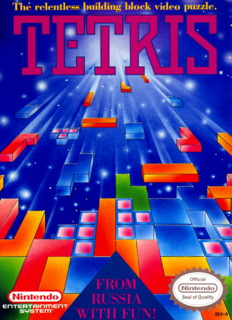The epitome of awesome that was the Game Boy
There have been more puzzle video games in the last twenty years than you could shake a number of sticks at, but Tetris is the one that I can always go back to. In case you're one of the eight people in the world who has never seen it, the game works like this; you have to assemble falling blocks of various odd shapes that fall from the top-center of the screen so that they fit together and form horizontal lines across the screen to earn you points, and if you aren’t able to assemble complete lines quickly enough it will be game over. Once you have a line, the line will disappear (or “clear”) and room is made for more falling blocks and more lines. There are seven types of blocks, and they are shaped like a capital “L”, a backwards capital “L”, a square, the letter “S”, the letter "Z", a shortened letter “T” and a long straight line. That may sound a bit restrictive, but the shapes and flush lines you can construct with them are almost limitless because they somehow manage to all fit into each other.
The way Tetris controls is very simple but also very important, and that is press the A-button to turn a piece clockwise, and press the B-button to turn a piece counterclockwise. On the original Game Boy, the player’s thumb tended to rest on the A-button, and for the longest time this never struck me as important until I finally became good enough to progress beyond level 10, upon which I learned that the importance is this; in those few fractions of a second it takes you to press A three times to get an “L” upside-down and ready to be pushed into its space, you could simply press B once and avoid the serious misstep of missing your gap, which at lower levels is not a huge problem, but at a high speed (level 15 and up) it can be the death knell for your current game because now you have a large “L” blocking your only path.
There are two modes of play in Tetris: A-Type and B-Type. A-Type is my preferred mode and the mode that comes to mind when one thinks of Tetris. The challenge that comes with this mode is twofold; assemble the falling blocks correctly before they pile up too high and to do it while the speed increases, forever. The speed increases ever so slightly every ten lines, at which point you go up one level, and depending on your skill level you can choose to start at every speed level from 0 to 9. There is no way to “win” in A-Type mode, because eventually the blocks WILL fall too fast for you to assemble lines in time and the game will end. The fun that comes in this is just trying to stave off a “game over” for as long as possible in as many ways as possible, and even after playing Tetris for years the fun and challenge is always there when going back to it. For those who don’t enjoy infinite gameplay there is the option of the “B-Type” game mode. In B-Type you choose your game speed just as in A-Type but you only have to complete 25 lines to “complete” the game. The fun that comes with B-Type is that you can choose how full the screen is when you start the game with the “High” setting of 0 to 5. Starting at a “High” level of 0 gives you a blank playing field like in A-Type, level 1 gives you broken lines two lines high, level 2 is four lines high and so on. It can be quite a challenge, but it is fun in its own right and is also great for practicing getting out of jams for A-Type as well.
While multiplayer gaming was just in its infancy, that didn’t stop Bullet-Proof Software from including a competitive 2-player mode that is as fun as it is plain. Once you get your Game Boy connection wires working correctly you will take on the avatar of either Mario or Luigi of Nintendo fame and play in a best-of-seven match; whoever gets to 25 lines first wins the game and whoever wins four games first wins the match. You can monitor how your opponent is doing by a bar on the side of the screen, and if your opponent clears two, three or four lines (the latter also known as a “tetris”) at a time one, two or four broken lines respectively will appear on the bottom of your playing field. This is either a curse or a blessing, because you’ll either be pushed too high and be unable to recover or you’ll clear up to another four lines just that much more quickly.
As much as I’d like to pretend I’m reviewing this game in 1989, I’m not. It’s 2007 and Tetris variants have been coming out ever since the originals in the late ‘80’s, but even with all the versions of Tetris out there this is a real case of “if it ain’t broke, don’t fix it.” There is no easy spin, no chain reactions, no button to make the blocks fall lightning fast, no timer and you can only see one block ahead instead of six because that is all you need to make sufficient judgment about where to place your pieces. The original pack-in Game Boy version is the superior version because it is Tetris at its simplest, purest form, and if you wrap up everything already touched upon in what may be the catchiest theme song known to mortal ears you get the perfect game; easy to pick up, easy to play and engrossing to anyone who touches it. It has been, is, and will be a grand achievement and the epitome of what the Game Boy has to offer.

